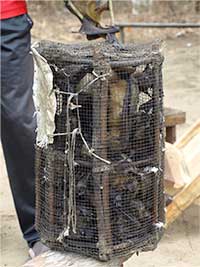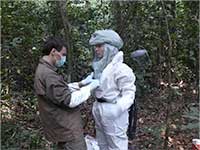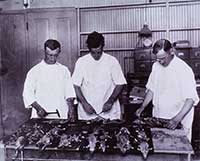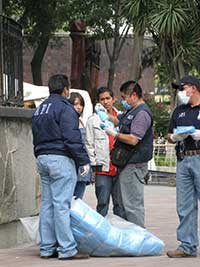Evolving threats: investigating new zoonotic infections Understand article
In the African forest, Fabian Leendertz and his team look for new infectious agents that can be transmitted from animals to humans. Could one of them cause the next pandemic?
Our modern lifestyle, in which we can travel around the globe in a matter of days, has made it easier for infectious diseases to spread. Pathogens that have recently been transmitted from animals to humans can be particularly dangerous because they are new to our immune system.
Fabian Leendertz at the Robert Koch Institutew1 in Berlin, Germany, studies previously unknown infectious microbes in Africa, hoping to prevent the outbreak of new zoonoses.

animals can be bought as
food. This is one way in
which zoonotic infections
can spread.
Image courtesy of Fabian
Leendertz
The word zoonosis, derived from the Greek words zoon (creature) and nosos (disease), describes an infectious disease that can be transmitted between animals and humans. Two established examples are rabies and bubonic plague, both of which can be deadly for humans. Whereas an epidemic affects a certain population, a pandemic is an infection spanning multiple continents or even the whole world.
Significantly, all recent pandemic outbreaks have been caused by animal pathogens that have recently evolved to broaden their host spectrum. Human immunodeficiency virus (HIV) originated in chimpanzees or gorillas, the 2003 outbreak of severe acute respiratory syndrome (SARS) was caused by an avian coronavirus, and the 2009 swine flu pandemic came from – well, you can guess.
How did these infections become such a serious and global danger? “The majority of human pathogens came from elsewhere in the animal kingdom,” Fabian explains, so that alone is not the explanation. However, “Today, it is far easier for a pathogen to spread between countries. What would have been a small incident in the past can now quickly become a worldwide outbreak.” Our increased mobility is not the only reason for this: “As human residential areas grow and humans enter more and more remote territories, we encounter new pathogens. Changing the local ecosystem eliminates some species and benefits others, some of which could bring zoonotic microbes with them.”
Ebola virus, for example, was passed from apes to humans, presumably by the consumption of ‘bush meat’: wild animals such as fruit bats or monkeys that are hunted for food. Often, they are butchered without gloves. If those animals have an infection, it can easily spread to the people hunting, butchering or eating them. In parts of Africa, wild animals are an important food source, and rapid population growth has stimulated the bush meat trade. Fabian’s research focuses on this method of disease transmission.
Monitoring our relatives’ health

biohazard suits when
extracting samples, to
protect them from dangerous
micro-organisms
Image courtesy of Fabian
Leendertz
The primates include not only humans, but also lemurs, monkeys and our closest relatives: the great apes, such as chimpanzees and gorillas. Any virus or bacterium that infects our primate relatives could also be dangerous to us. To identify new infectious agents that jump the species barrier, therefore, the German researchers teamed up with behavioural scientists in Ivory Coast, West Africa, to study the great apes. They collaborate as part of the Great Ape Health Monitoring Unitw2, an institute that provides space to researchers from around the world who want to obtain samples from wild apes. Whenever one of the apes that they are studying becomes ill or dies, the team collects blood, faeces and urine samples to send to Fabian and his group in Berlin. If the ape dies, it is autopsied on-site by one of the veterinarians.
Identifying the responsible pathogen
When the samples arrive in Fabian’s lab in Berlin, he and his co-workers try to find out which pathogen is behind the outbreak – and if it is already known. Several laboratory tests can expose the identity of the microbe, by revealing its genome sequence or characteristic surface molecules.
One such technique, the polymerase chain reaction (PCR), multiplies DNA sequences and makes them easier to identify. Fabian then searches for regions that are unique to certain micro-organisms. If one of those specific sequences is present in the sample, the pathogen can be identified as belonging to a certain bacterial or viral family.
By testing different types of sample – blood, faeces or urine – the scientists can search for specific types of disease, for example those caused by respiratory, intestinal or systemic pathogens.
If the pathogen is an unknown micro-organism, “we try to culture it and isolate the whole genome for sequencing. Then we present the newly discovered microbe to the scientific world,” Fabian explains.
Can it infect us?

rats at the Port of New
Orleans in 1914, prompting a
major rat eradication effort.
These three men are
examining rats for the
disease.
Public domain image /
Wikimedia Commons
Does the newly discovered microbe infect only apes or can it be transmitted to humans? If people can be infected, will they become ill? Could they pass the disease on to other humans? To answer these questions, the German scientists travel to Africa and take samples from people living close to where the virus was found; these people are not necessarily ill, but could have antibodies in their blood that indicate a past infection. The scientists also work with local doctors who send samples to Germany.

masks in Mexico City during
the 2009 flu pandemic
Image courtesy of
kalitemarketing.com
If the microbe is found in human samples, it could have been acquired either directly from apes or indirectly from another host. To determine whether it might cause an epidemic or even a pandemic, the researchers try to find out if it can be passed from one person to another. This is a difficult task, involving interviewing lots of villagers. Have they had close contact with apes or with ill people? Where and when? Using this data, the researchers hope eventually to identify the source and the means of transmission of the newly discovered pathogen.
If the pathogen proves to be dangerous, the health authorities are notified and take charge of emergency measures. Sick people are quarantined, doctors and nurses are called to the outbreak zone, and bush markets and public transport may be shut down temporarily.
The researchers themselves also need to be careful. “We carry a mobile miniature lab with which we can instantly test for the most dangerous species, like Ebola virus,” explains Fabian. Until it is clear what microbes they are dealing with, they protect themselves with biohazard suits.
The outlook
The research strategy has proved successful: in recent years, the group discovered why wild chimpanzees had started dying of anthrax (Leendertz et al., 2004). Fabian and his colleagues found that a previously harmless soil bacterium (Bacillus cereus) had acquired – from a related pathogenic bacterium (Bacillus anthracis) – the genetic information to produce the dangerous anthrax toxin. The bacterial strain that evolved from this genetic transfer (Bacillus cereus anthracis) can live in the soil and is highly virulent, thus posing a lethal threat to chimpanzees. The next step will now be to test whether this specific strain is found in the local human population and, if so, how humans can be protected, for example, by vaccination.
References
- Leendertz FH et al. (2004) Anthrax kills wild chimpanzees in a tropical rainforest. Nature 430: 451-452. doi: 10.1038/nature02722
Web References
- w1 – Website of the Robert Koch Institute, the German centre for disease control
- w2 – Website of the Great Ape Health Monitoring Unit
Resources
- To learn about the ecology of bird flu, another zoonotic infection, see:
- Niekoop L, Rienks F (2006) The ecologist’s view of bird flu. Science in School 3: 24-30.
- The University of Minnesota has created ‘Outbreak at Watersedge’, an online game in which you track the source of an outbreak of illness.
- In the online game Pandemic II, you are a virus, parasite or bacterium with the goal of infecting and killing everyone on the planet.
- In a TEDed video, Mark Honigsbaum describes the history of pandemics and how that knowledge can help to halt future outbreaks.
- To learn more about a very different hazard of human–wildlife interactions, see:
- Notman N (2012) Cracking down on wildlife trafficking. Science in School 24: 6-11.
Review
This comprehensive and simply written article about research into zoonotic infections can be used in biology lessons to address the topics of evolution, health, ecosystems or climate change. Suitable comprehension and extension questions include:
- Why are zootonic infectious so dangerous?
- How may environmental changes cause more zootonic infections in the near future?
- What could governments do to prevent new pandemics?
- What tests allow scientists to determine if an individual has been infected by a zoonosis?
- How should authorities manage an emergency of a pandemic caused by zoonosis?
This article could also be used to stimulate discussions about the history of infectious diseases; the interactions of organisms with their environment; and recent food security scandals. Starting with the known zoonoses mentioned in the article, it could be used to discuss the economic, social and political consequences of recent pandemics.
Panagiotis Stasinakis, 4th Lyceum of Zografou, Greece





